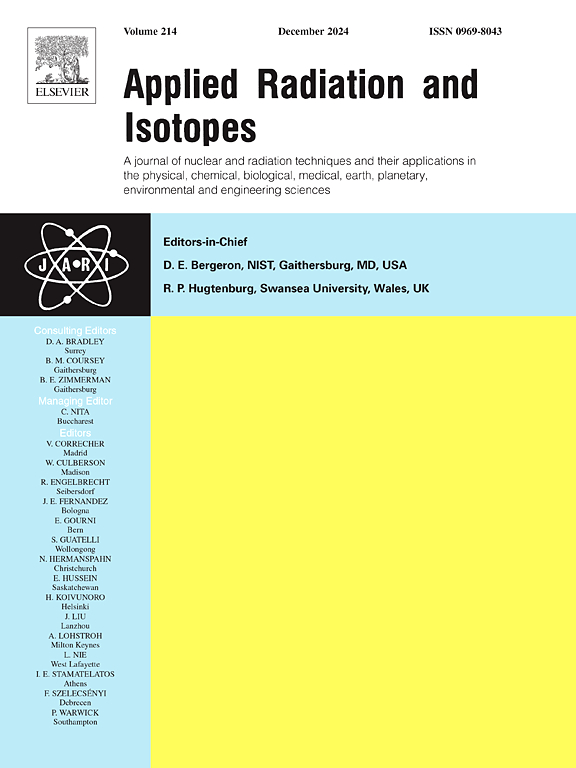通过计算和经验方法研究横截面对 HPGe 探测器响应的影响。
IF 1.6
3区 工程技术
Q3 CHEMISTRY, INORGANIC & NUCLEAR
引用次数: 0
摘要
实验测量和模拟相结合,为了解伽马射线光谱仪的性能和局限性,特别是在特定能量范围内的性能和局限性提供了宝贵的见解。本研究调查了截面变化对高纯锗(HPGe)探测器响应的影响,重点是 53 keV 至 1408 keV 的能量范围。在使用 MCNP5 代码和两个不同的截面库(ENDF/B.VI 和 JENDL-5)进行蒙特卡罗模拟的同时,还利用 ANGLE 4.0 软件进行了半经验法模拟。这种方法可以全面探索截面变化如何影响 HPGe 探测器的响应。库选择的灵活性凸显了 MCNP 满足特定能量要求的适应性。然后将计算出的效率与实验数据进行比较,以评估准确性和可靠性。结果表明,实验值和模拟值的一致性在 [2-3%] 以内,特别是在 121 keV 以上的能量范围。值得注意的是,对于低能范围(53-121 千伏),ENDF/B.VI 库的精确度在 [3-5%] 以内,这使它能有效捕捉低能相互作用并提高预测精度。这一精确度突出了ENDF/B.VI库在捕捉低能相互作用和提高预测精确度方面的适用性。总之,这项研究为探测器的性能提供了宝贵的见解,并强调了选择库在确保模拟精度方面的重要性。本文章由计算机程序翻译,如有差异,请以英文原文为准。
Investigating cross-section effects on HPGe detector response through computational and empirical approaches
The combination of experimental measurements and simulations provides valuable insights into the performance and limitations of gamma-ray spectrometry, especially within a specified energy range. This study investigates the impact of cross-section variations on the response of high-purity germanium (HPGe) detectors, focusing on the energy range from 53 keV to 1408 keV.
Monte Carlo simulations using the MCNP5 code with two different cross-section libraries, ENDF/B.VI and JENDL-5, are conducted alongside a semi-empirical method utilizing ANGLE 4.0 software. This approach allows for a comprehensive exploration of how cross-section variations affect HPGe detector response.
The flexibility in library selection highlights the adaptability of MCNP to cater to specific energy requirements. The calculated efficiencies are then compared with experimental data to evaluate accuracy and reliability. The results reveal an agreement within [2–3%] between experimental and simulated values, particularly for energies above 121 keV. Notably, for low-energy ranges (53–121 keV), the ENDF/B.VI library achieves an accuracy within [3–5%], making it effective at capturing low-energy interactions and enhancing prediction precision. This accuracy highlights its suitability for capturing low-energy interactions and enhances prediction precision.
Overall, this study provides valuable insights into detector performance and underscores the significance of library choice in ensuring simulation accuracy.
求助全文
通过发布文献求助,成功后即可免费获取论文全文。
去求助
来源期刊

Applied Radiation and Isotopes
工程技术-核科学技术
CiteScore
3.00
自引率
12.50%
发文量
406
审稿时长
13.5 months
期刊介绍:
Applied Radiation and Isotopes provides a high quality medium for the publication of substantial, original and scientific and technological papers on the development and peaceful application of nuclear, radiation and radionuclide techniques in chemistry, physics, biochemistry, biology, medicine, security, engineering and in the earth, planetary and environmental sciences, all including dosimetry. Nuclear techniques are defined in the broadest sense and both experimental and theoretical papers are welcome. They include the development and use of α- and β-particles, X-rays and γ-rays, neutrons and other nuclear particles and radiations from all sources, including radionuclides, synchrotron sources, cyclotrons and reactors and from the natural environment.
The journal aims to publish papers with significance to an international audience, containing substantial novelty and scientific impact. The Editors reserve the rights to reject, with or without external review, papers that do not meet these criteria.
Papers dealing with radiation processing, i.e., where radiation is used to bring about a biological, chemical or physical change in a material, should be directed to our sister journal Radiation Physics and Chemistry.
 求助内容:
求助内容: 应助结果提醒方式:
应助结果提醒方式:


